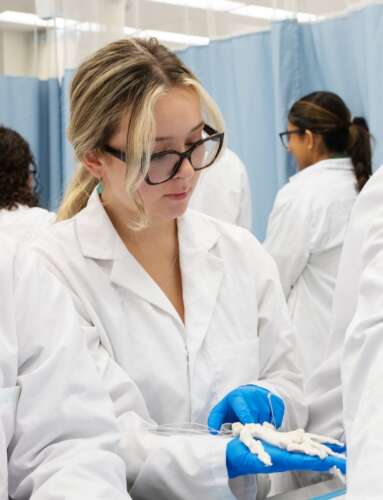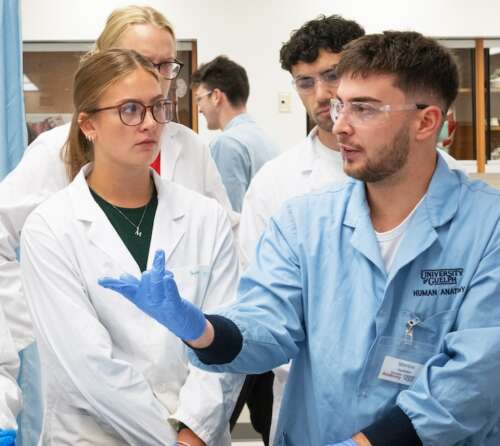In a textbook, the mysterious marvels of the human body are often contained to the black and white of its pages. At the University of Guelph, knowledge leaps from the page and quite literally into the hands of students inside the Human Anatomy Lab.
Part of the College of Biological Science, the lab is a hub of discovery where undergraduate students pursuing careers in medicine, health care and research can study anatomical structures using human bodies.
“We can teach at the level of detail we do because we have the luxury of this lab,” says Dr. Lorraine Jadeski, professor in the Department of Human Health and Nutritional Sciences whose expertise in dissection-based anatomy is at the heart of the lab’s operation.
“Donating your body to science education is an invaluable contribution,” she adds.
Human Anatomy Lab a unique U of G learning experience
It was during high school that Dr. Naythrah Thevathasan, a 2014 graduate of the Biomedical Science program, began volunteering in the lab. That experience sealed her decision to enroll at U of G.
“Very few undergrad programs allowed students to have dissections,” she says. “A decade later, I’ve never forgotten the role that U of G, and above all, the Human Anatomy Lab, played in my education and my career.”

Thevathasan is now a medical school graduate in her third year of a pediatric residency who recently completed a scholarship at Boston Children’s Hospital, the Harvard Medical School Teaching Hospital. She says the skills she acquired in the lab are put to use every day in the ICU managing a critically ill child.
It is not just a lab where technical scientific learning takes place, but a family and a community, she says. Teamwork and communication teach students how to support and learn from one another, an experience unique to U of G because of the independence students are granted.
U of G’s Human Anatomy Program launched in 1968 and for decades, operated with donors from local medical schools. However, as the program’s needs increased, and a shortage of donations began worldwide, the Human Body Donation Program was initiated in 2006 following a donor request to work with U of G directly.
“We’re very thankful to the generous people who are forward-thinking enough to give the gift of learning,” Jadeski says. “Students arrive with their passion and curiosity and thirst for learning, and they work hard utilizing that gift.
“We want our donors to be teachers,” she adds. “They will save lives.”
With a team that includes technician Nina Andrejic, Jadeski instructs students across disciplines that include human kinetics, biomedical science and neuroscience, among others.
Human anatomy students learn in small groups, attending lectures and full-dissection lab courses with mentorship and collaboration in postgraduate studies. Together they are building vital skills to meet the demands of an increasingly dynamic and multidisciplinary health care system.
The lab has also extended its use to community partners that include emergency room doctors, first responders such as firefighters and paramedics to enhance their education and skills.
“The ripple effects of one person’s choice to donate are so vast,” Andrejic points out.
Respect, trust in the lab prepares future health care professionals

A culture of respect is the foundation on which the lab is built. Respect for the donors and their families, for the work, for colleagues, even the language used. “They are our donors, not the donors,” Andrejic says.
Each spring donors and their families are honoured at a Celebration of Life and Learning where students are able to extend thanks personally and share what they have gained through the gift of learning.
A private committal service for internment and burial of donor ashes at Woodlawn Memorial Park follows.
The respect and trust the lab prioritizes are the values Thevathasan sees health care professionals practice as patients put their trust in them providing intimate details about their health and their body.
“Using your knowledge to help patients is the ultimate form of trust and gratitude,” she says. “That began by understanding the gratitude of sharing your learning experience with someone who donated their body for you to do so.”
